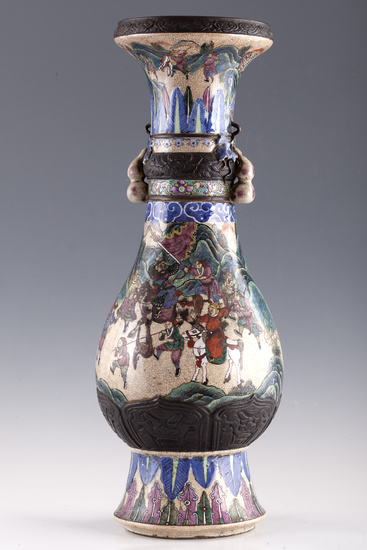Ge-Ware style vase. China, Qing Dynasty, 19th century.
Ge-Ware style vase. China, Qing Dynasty, 19th century.
In porcelain.
Measures: 61 x 21.50 cm.
Chinese vase with globular body and narrow mouth in Ge-Ware ceramic. It presents a delicate crackle as a high quality decorative element on which different characters such as soldiers and other more natural figures such as palm trees and pumpkins are glazed.
Ge-ware or Ko ware is a type of celadon or greenware in Chinese ceramics. Its distinguishing feature is the deliberate crackle, or a network of cracks in the glaze.
Under the Qing, inherited art forms flourished and innovations occurred at many levels and in many types. High levels of literacy, a successful publishing industry, thriving cities and a Confucian emphasis on cultivation nurtured a lively and creative set of cultural fields. By the end of the 19th century, the national artistic and cultural worlds had begun to reconcile with the cosmopolitan culture of the West and Japan. The decision to remain within the old forms or to welcome Western models was now a conscious choice rather than an unquestioning acceptance of tradition. Classically trained Confucian scholars. The Qing emperors were generally skilled in poetry and often skilled in painting, and offered their patronage to Confucian culture.
HELP
View it on
Estimate
Time
Auction House
Ge-Ware style vase. China, Qing Dynasty, 19th century.
In porcelain.
Measures: 61 x 21.50 cm.
Chinese vase with globular body and narrow mouth in Ge-Ware ceramic. It presents a delicate crackle as a high quality decorative element on which different characters such as soldiers and other more natural figures such as palm trees and pumpkins are glazed.
Ge-ware or Ko ware is a type of celadon or greenware in Chinese ceramics. Its distinguishing feature is the deliberate crackle, or a network of cracks in the glaze.
Under the Qing, inherited art forms flourished and innovations occurred at many levels and in many types. High levels of literacy, a successful publishing industry, thriving cities and a Confucian emphasis on cultivation nurtured a lively and creative set of cultural fields. By the end of the 19th century, the national artistic and cultural worlds had begun to reconcile with the cosmopolitan culture of the West and Japan. The decision to remain within the old forms or to welcome Western models was now a conscious choice rather than an unquestioning acceptance of tradition. Classically trained Confucian scholars. The Qing emperors were generally skilled in poetry and often skilled in painting, and offered their patronage to Confucian culture.
HELP



